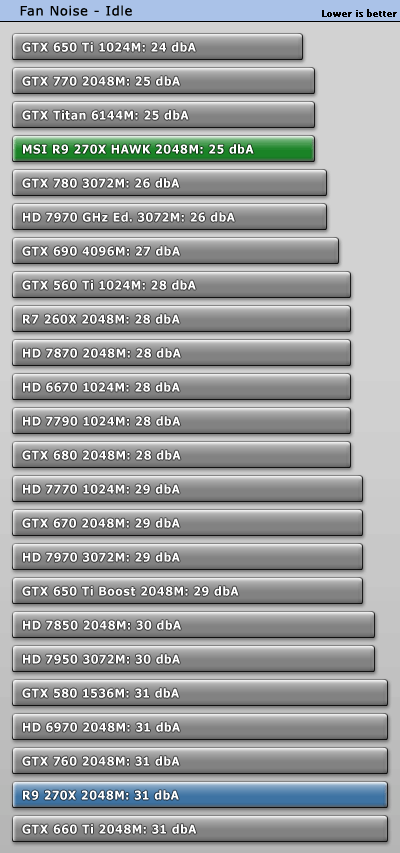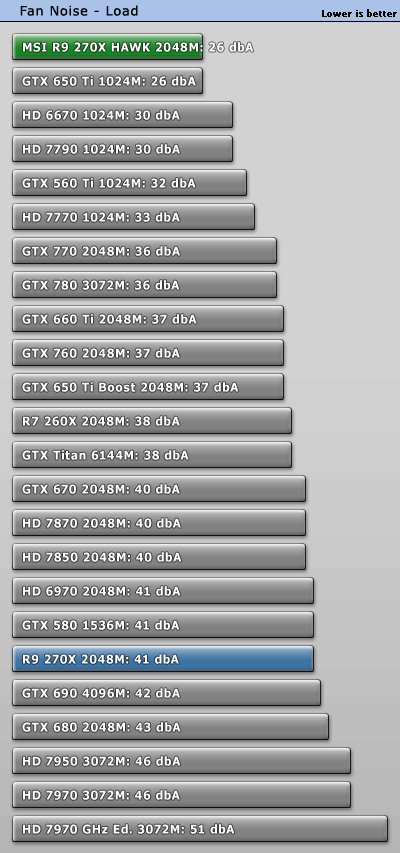 9
9
MSI R9 270X HAWK 2 GB Review
Performance Summary »Fan Noise
In past years, gamers would accept everything for a little bit more performance. Nowadays, users are more aware of the fan noise and the power consumption of their graphics cards.We use the Bruel & Kjaer 2236 sound-level meter (~$4,000) to properly test the fan noise a card emits. It has the measurement range and accuracy we are looking for.

The tested graphics card was installed in a system that was completely cooled system passively. That is, passive PSU, passive CPU cooler, and passive cooling on the motherboard and a solid state drive. Noise results of other cards on this page are measurements of the respective reference design.
This setup allows us to eliminate secondary noise sources and test only the video card. To be more compliant with standards like DIN 45635 (we are not claiming to be fully DIN 45635 certified), the measurement was conducted at a distance of 100 cm and 160 cm off the floor. Ambient background noise in the room was well below 20 dBA for all measurements. Please note that the dBA scale is not linear but logarithmic. 40 dBA is not twice as loud as 20 dBA, as a 3 dBA increase results in double the sound pressure. The human hearing perception is a bit different, and it is generally accepted that a 10 dBA increase doubles the perceived sound level. 3D load noise levels were tested with a stressful game, not with Furmark.
Fan noise in both idle and load is very, very good. The card is probably the quietest card in its performance segment. In idle, the fan is inaudible when installed in a case with other actively cooled components. When gaming, the fan ramps up just a little bit to handle the extra heat, but still stays nearly inaudible.


Apr 17th, 2025 01:41 EDT
change timezone
Latest GPU Drivers
New Forum Posts
- Need advice RAM for Asus Maximus hero z890 + core ultra 7 265k (33)
- Advice for DDR5 CU-DIMM 2 x 24gb 8400mhz (32)
- How to relubricate a fan and/or service a troublesome/noisy fan. (241)
- EVGA 3070ti hotspot is too high 107.7° (10)
- Windows 11 fresh install to do list (37)
- Will you buy a RTX 5090? (479)
- 5070 Ti power limit questions (42)
- 3DMARK "LEGENDARY" (298)
- Help needed OC on Intel 285k (0)
- Technical Issues - TPU Main Site & Forum (2025) (99)
Popular Reviews
- G.SKILL Trident Z5 NEO RGB DDR5-6000 32 GB CL26 Review - AMD EXPO
- ASUS GeForce RTX 5060 Ti TUF OC 16 GB Review
- ASUS GeForce RTX 5080 TUF OC Review
- NVIDIA GeForce RTX 5060 Ti PCI-Express x8 Scaling
- DAREU A950 Wing Review
- Palit GeForce RTX 5060 Ti Infinity 3 16 GB Review
- The Last Of Us Part 2 Performance Benchmark Review - 30 GPUs Compared
- ASUS GeForce RTX 5060 Ti Prime OC 16 GB Review
- Zotac GeForce RTX 5060 Ti AMP 16 GB Review
- Sapphire Radeon RX 9070 XT Pulse Review
Controversial News Posts
- NVIDIA GeForce RTX 5060 Ti 16 GB SKU Likely Launching at $499, According to Supply Chain Leak (182)
- NVIDIA Sends MSRP Numbers to Partners: GeForce RTX 5060 Ti 8 GB at $379, RTX 5060 Ti 16 GB at $429 (127)
- Nintendo Confirms That Switch 2 Joy-Cons Will Not Utilize Hall Effect Stick Technology (105)
- Over 200,000 Sold Radeon RX 9070 and RX 9070 XT GPUs? AMD Says No Number was Given (100)
- Nintendo Switch 2 Launches June 5 at $449.99 with New Hardware and Games (99)
- NVIDIA Launches GeForce RTX 5060 Series, Beginning with RTX 5060 Ti This Week (92)
- Sony Increases the PS5 Pricing in EMEA and ANZ by Around 25 Percent (85)
- NVIDIA PhysX and Flow Made Fully Open-Source (77)
